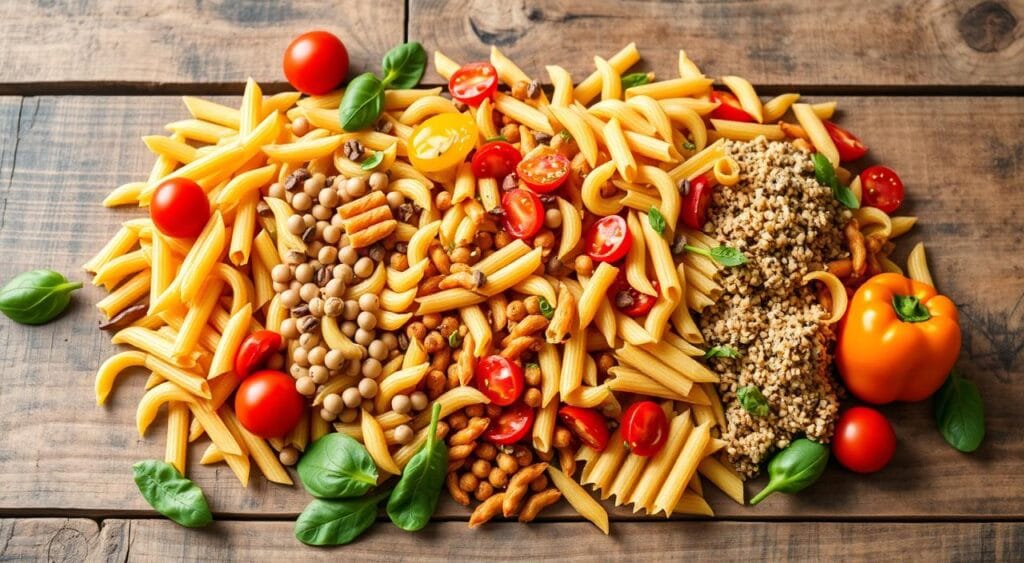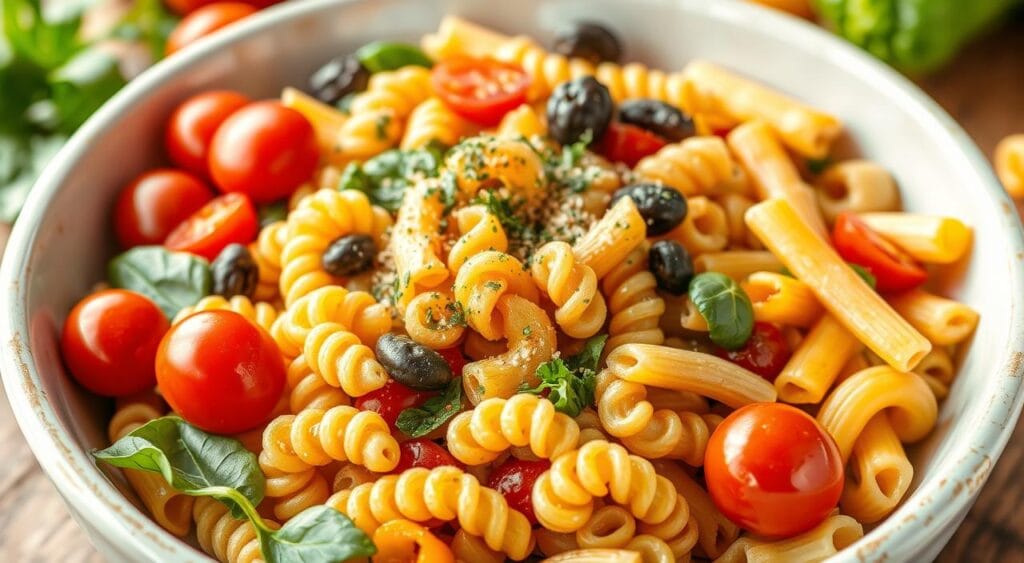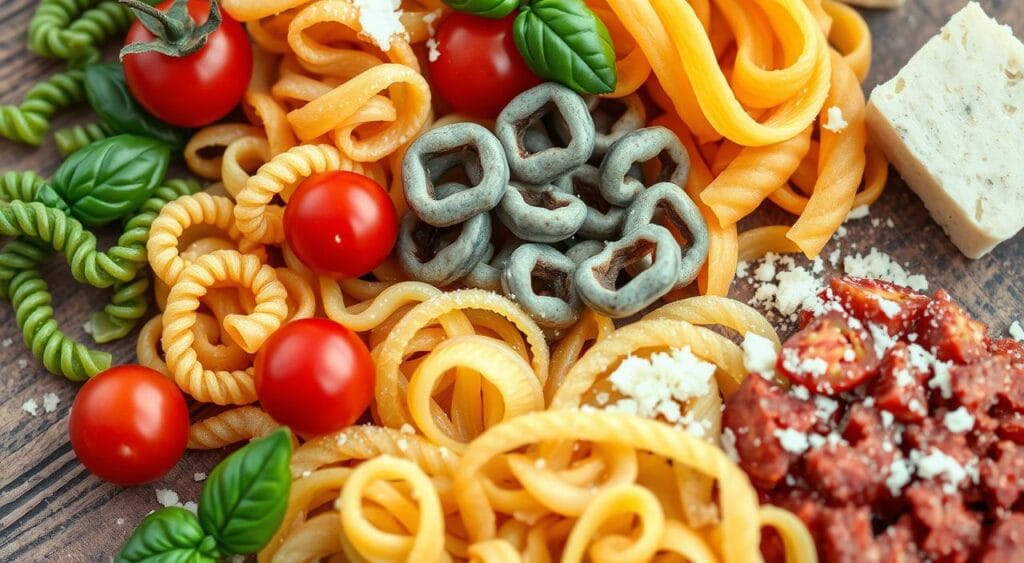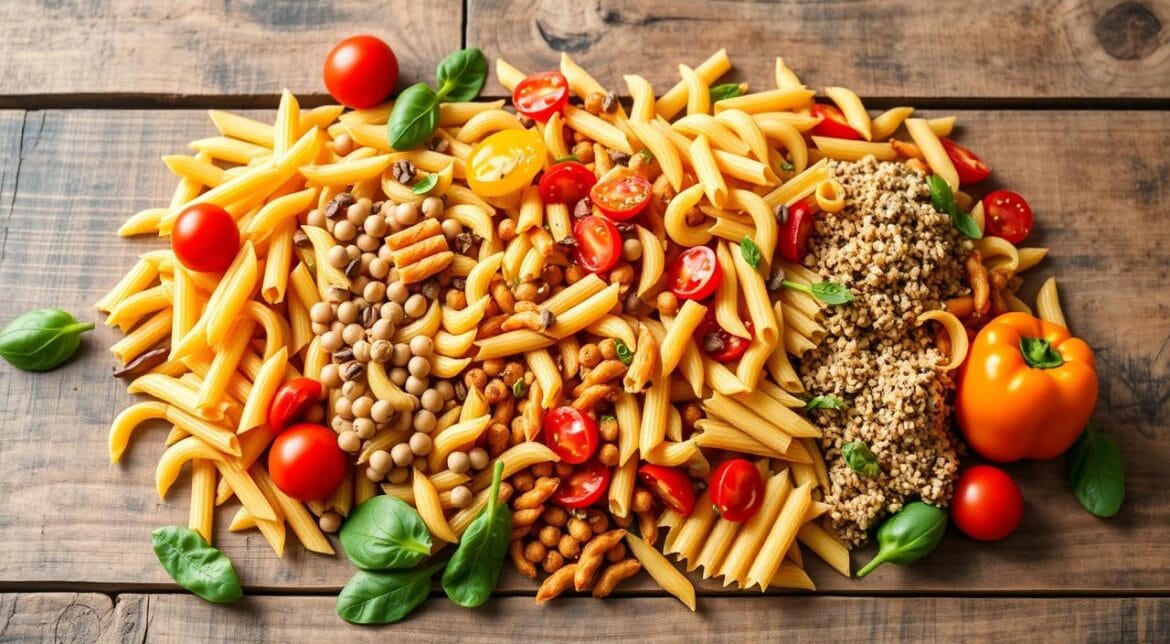Table of Contents
High-protein pastas are becoming more popular for those who want healthy and tasty meals. Each serving provides a significant amount of protein. This makes them great for muscle recovery, a balanced diet, or just trying new foods.

Key Takeaways
- High-protein pastas provide a nutrient-dense option for those seeking to enhance their protein intake.
- These alternative pasta varieties are made from a range of ingredients, including legumes, ancient grains, and alternative flour sources.
- Protein-enriched pastas offer a variety of health benefits, from supporting muscle growth to promoting satiety.
- Exploring the different types of high-protein pastas can help you find the best fit for your dietary needs and taste preferences.
- Incorporating high-protein pastas into your meals can be a simple and delicious way to boost your protein consumption.
Understanding Protein-Enriched Pasta Alternatives
Traditional pasta may not always be the healthiest choice. But, protein-enriched pasta alternatives offer a nutritious option. These products have protein and other benefits that are good for your diet.
Traditional vs. Protein-Enhanced Pasta Comparison
Protein-enhanced pasta has a better nutritional profile than regular pasta. It has up to twice the protein per serving. This is great for those who want more protein or need to keep their muscles strong.
Benefits of Choosing Protein-Rich Pasta
- It makes you feel full, which helps with weight management.
- It supports muscle growth and maintenance, especially for the active.
- It helps maintain stable blood sugar levels, benefiting those with diabetes.
- It improves nutrient absorption, helping your body get more vitamins and minerals.
Key Nutrients in Enhanced Pasta Products
Protein-enriched pastas also have more nutrients than regular pasta. They have more fiber, complex carbs, and important minerals like iron and B vitamins. This makes them a healthier choice for your meals.

“Incorporating protein-enriched pasta into your diet can be a simple and delicious way to boost your daily nutrient intake and support your overall health.”
The Science Behind High-Protein Pastas
Making high-protein pastas is a mix of science and cooking skills. It’s all about picking and mixing different protein sources. Unlike regular pasta, which gets its protein from gluten, these noodles use new ingredients for more nutrition.
Legume flours like chickpea, lentil, or soybean are key. They add protein and special tastes and textures. Mixing these flours with semolina or whole-wheat flour keeps the pasta’s feel but boosts its health.
Whey or egg proteins are also used. They give the pasta a full amino acid mix, making it even better. How the pasta is made, from extrusion to drying, is important. It makes sure the proteins work well and stay nutritious.
| Ingredient | Protein Content | Impact on Pasta |
|---|---|---|
| Chickpea Flour | 15-25g per 100g | Increased protein, nutty flavor, and firm texture |
| Lentil Flour | 20-30g per 100g | High protein, earthy taste, and al dente bite |
| Whey Protein | 80-90g per 100g | Exceptional protein content, smooth mouthfeel |
The science of high-protein pastas is about knowing how these new ingredients work. By adjusting the mix and making process, makers can create tasty, healthy noodles.

Popular Types of High-Protein Pastas Ingredients
High protein pastas come in many forms, each with its own nutritional benefits. They range from legume-based to ancient grain varieties. This variety meets different dietary needs and tastes.
Legume-Based Options
Legume-based pastas, like those from chickpeas or lentils, are getting more popular. They are packed with protein and offer essential nutrients like fiber and vitamins. These noodles are great for those who follow a plant-based diet.
Ancient Grain Varieties
Ancient grains like quinoa, spelt, and amaranth are also used to make protein-rich noodles. These pastas have a unique taste and texture. They offer a different culinary experience for those looking to try something new.
Alternative Flour Sources
Some pasta makers use non-traditional flours to boost protein content. Almond flour, coconut flour, and cauliflower-based pastas are now available. They cater to those who need gluten-free or low-carb options.
These high protein pastas are a healthier choice compared to regular wheat noodles. They are perfect for anyone looking to increase their protein intake and improve their health.
Best Commercial Brands for Protein Noodles
The market has many protein noodles for health-conscious people. These protein-enriched pasta options add nutrition and fit different diets. Let’s look at some top brands for protein noodles.
Banza leads with chickpea pasta, offering 25 grams of protein per serving. It’s a great choice for a healthy pasta. Quest Nutrition also makes protein noodles from konjac root. These noodles are low in calories and carbs.
For ancient grain fans, Tolerant Foods and Explore Cuisine are good. They use lentils, peas, and other legumes for their noodles. These noodles are not only high in protein but also tasty and satisfying.
| Brand | Protein Content (per serving) | Key Ingredients | Dietary Considerations |
|---|---|---|---|
| Banza | 25g | Chickpea flour | Gluten-free, high in protein |
| Quest Nutrition | 20g | Konjac root | Low-calorie, low-carb |
| Tolerant Foods | 21g | Lentil flour | Gluten-free, high in protein |
| Explore Cuisine | 23g | Mung bean, edamame, black bean | Gluten-free, high in protein |
When picking protein noodles, think about texture, cooking, and nutrition. With many quality brands, you’ll find the right protein-enriched pasta for you.
How to Choose the Right High-Protein Pasta
Choosing the right high-protein pasta involves several factors. Texture, cooking properties, and nutritional profiles are key. Making an informed choice helps you find the perfect pasta for your diet and taste.
Texture Considerations
Protein-enriched pastas come in different textures. You might prefer the firm bite of legume-based varieties or the soft feel of ancient grain options. Think about what texture you like best and how it will work with your favorite sauces and toppings.
Cooking Properties
High-protein pastas cook differently than regular pasta. They might take longer to cook and absorb more water. Always follow the package instructions and adjust your cooking methods to get the right consistency.
Nutritional Profile Analysis
Look at the nutrition facts to compare protein, fiber, and carbs in different high-protein pastas. This helps you pick the one that fits your dietary goals. Whether you want low-carb, high-protein, or balanced meals, you can find the right pasta.
Exploring texture, cooking, and nutrition in high-protein pastas helps you find the best one. This way, you can make your pasta dishes even better and support your high protein pastas lifestyle.
Cooking Tips for Perfect Protein Pasta
Cooking high-protein pasta is a fun adventure. But, it needs some extra care for the perfect texture and taste. Whether you’re making a dish with how to add protein to pasta or enjoying protein noodles, these tips will help you cook like a pro.
Water Ratio and Cooking Time
Protein pasta needs more water than regular pasta. Use about 1 cup of water for every 2 ounces of dry pasta. Also, it might take a few extra minutes to cook to the perfect al dente.
Seasoning and Sauces
Be creative with your seasonings and sauces for how to add protein to pasta. Protein pasta goes well with bold spices, herbs, and rich sauces. Try garlic, basil, or lemon to enhance the taste of your protein noodles.
Tossing Technique
- Gently toss the cooked pasta with your sauce using tongs or forks.
- Don’t over-stir to avoid making the pasta gummy or mushy.
- Use a bit of reserved pasta water to help the sauce stick to the noodles.
Follow these tips to make delicious, protein-rich pasta dishes. Enjoy your tasty creations!
| Cooking Tip | Description |
|---|---|
| Water Ratio | Use about 1 cup of water for every 2 ounces of dry protein-enriched pasta. |
| Cooking Time | Protein pastas may require a few extra minutes of cooking to achieve the ideal al dente texture. |
| Seasoning and Sauces | Experiment with bold spices, herbs, and rich sauces to complement the unique flavors of protein-rich pastas. |
| Tossing Technique | Gently toss the cooked pasta with your sauce, avoiding over-stirring to prevent the noodles from becoming gummy or mushy. |
“Perfecting the technique of cooking protein-rich pasta is essential for creating a variety of delicious and nutritious pasta dishes.”
Nutritional Benefits and Macronutrient Breakdown
High-protein pastas offer a big nutritional advantage. They have more protein than regular pasta. This makes them an excellent option for a healthy diet.
Protein Content Comparison
High protein pastas have more protein than regular pasta. For example, regular pasta has about 8 grams of protein. But, lentil or chickpea pasta can have up to 25 grams. This is great for people who are active or want to build muscle.
Fiber and Carbohydrate Analysis
High protein pastas also have more fiber. Legume-based and ancient grain pastas can have up to 8 grams of fiber. This helps with digestion and feeling full. But, some protein-enriched pastas have less carbs, which is good for low-carb diets.
Micronutrient Profile
Protein pasta is also packed with vitamins and minerals. It can have iron, folate, and B vitamins. This adds extra nutrition to your meals.
Looking to eat more protein or fiber? High protein pastas are a smart choice. They’re good for your health and taste great.
| Nutrient | Traditional Wheat Pasta | High-Protein Pasta (Lentil or Chickpea) |
|---|---|---|
| Protein (per serving) | 8g | 25g |
| Fiber (per serving) | 2g | 8g |
| Carbohydrates (per serving) | 40g | 30g |
“Including high-protein pastas in your diet is an easy and tasty way to enhance your nutrient intake and promote overall health and wellness.”
Recipe Ideas for High-Protein Pasta Dishes
Adding high-protein pasta to your meals is tasty and healthy. It’s great for boosting your protein intake. Whether you need quick dinners or fancy meals, these ideas will help you use protein-rich noodles in your cooking.
Creamy Chicken and Broccoli Pasta
Mix protein noodles with grilled chicken, steamed broccoli, and creamy sauce. This meal is both filling and full of nutrients. The pasta, chicken, and veggies make it a healthy choice.
Lentil Bolognese with Zucchini Noodles
Try a meatless version of Bolognese with how to add protein to pasta. Use lentil sauce and zucchini noodles. It’s rich in plant-based protein, fiber, and vitamins.
Shrimp Scampi with Whole Wheat Pasta
Make a fancy shrimp scampi dish with protein noodles. The shrimp and garlic-butter sauce go well with the pasta’s nutty taste and firm texture.
Vegetable Stir-Fry with Quinoa Noodles
For a fast, healthy dinner, mix fresh veggies with how to add protein to pasta made from quinoa. It’s a dish full of nutrients and tastes great.
“Incorporating high-protein pastas into your meals is a simple way to boost your nutrient intake and keep you feeling full and energized.”
There are countless ways to make tasty, healthy dishes with protein noodles. Try new ingredients, spices, and cooking methods to find your top high-protein pasta recipes.
Common Misconceptions About Protein-Enhanced Pasta
There are many myths about protein-enriched pasta that might stop people from trying it. Let’s look at and clear up some common myths about its taste, texture, and health benefits.
Taste and Texture Myths
Many worry that protein pasta tastes and feels different from regular pasta. But, this isn’t usually true. Top brands have made protein pasta that tastes and feels just like the real thing. Protein pasta is not gritty or chalky.
Health Impact Facts
Some think protein pasta is less healthy or has more calories than regular pasta. But, the extra protein in these pastas has many benefits. It can make you feel full longer, help muscles grow, and even help with weight control. Yes, protein pasta can be a healthy choice for a balanced diet.
By clearing up these myths, we can get more people to try protein-enriched pasta. It offers many advantages. Knowing the facts helps you decide if protein pasta is healthy for you.
| Myth | Fact |
|---|---|
| Protein pasta has a gritty or chalky texture. | Many protein pasta brands have achieved a similar mouthfeel and al dente bite as traditional semolina pasta. |
| Protein-enhanced pasta is less healthy than regular pasta. | Protein-rich pasta can provide benefits like increased satiety, muscle support, and potential weight management. |
Who Should Consider Switching to Protein Pasta
If you’re an athlete or always on the move, high-protein pastas are great for you. They give you the amino acids you need for muscle repair and growth. Vegetarians and vegans might also like them for their protein boost.
For those watching their weight or blood sugar, protein pasta is a big help. It keeps you full, which can cut down on calories. It also digests slowly, which helps keep blood sugar steady. This is beneficial for individuals with diabetes or prediabetes.
Adding high-protein pastas to your meals can improve your health. They’re good for anyone wanting to stay active, eat well, or manage health issues. Protein-enriched pasta is a tasty and healthy choice for your meals.
FAQ
Does traditional pasta contain protein?
Traditional pasta, made from wheat flour, has about 3-4 grams of protein per serving. This protein comes from the wheat used in making the pasta.
What are the benefits of choosing protein-rich pasta?
Protein-rich pasta helps you feel full longer. It’s good for muscle health and has more nutrients. It’s great for athletes, those watching their weight, or following a plant-based diet.
How is protein added to pasta?
Protein is added by using different flours like legumes, ancient grains, or nut flours. These are mixed with wheat flour to make a pasta that’s packed with nutrients.
Is protein pasta considered a healthy choice?
Yes, protein pasta is a healthy option. It has more fiber and better nutrients than regular pasta. But, always check the ingredients and nutritional info of the pasta you choose.
What are some popular types of protein-rich pasta ingredients?
Popular protein-rich pasta ingredients include: – Legumes like chickpea, lentil, black bean – Ancient grains like quinoa, spelt, buckwheat – Alternative flours like almond, coconut, pea These add a lot of protein to pasta.
How do I choose the right high-protein pasta for my needs?
Look at the pasta’s texture, cooking, and nutrition. Check the protein, fiber, and carbs to match your diet and health goals.
How can I incorporate protein pasta into my diet?
Use protein pasta in many dishes, from classic pasta to salads. Try different types and recipes. Pair it with healthy sauces, veggies, and lean proteins for a balanced meal.

